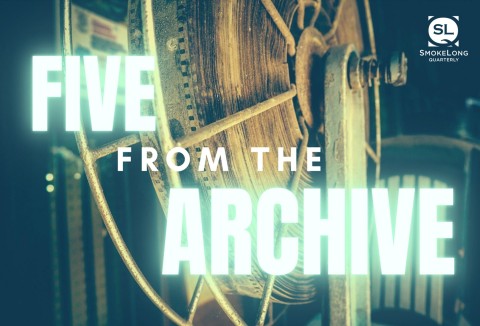
The following is part of SmokeLong‘s series Five from the Archive, which fulfills a need for teaching resources in the flash-narrative community and beyond. In this installment, Sharmini Aphrodite takes a look at five magical realism stories in the SmokeLong story archive.
______________________
by Sharmini Aphrodite
Magical Realism (also magic realism) is a movement that spans various artistic mediums, having been utilised in film and television, the visual arts, literature and more. A response to the movement of “realism”, magical realism differs from the fantasy genre based on its treatment of the surreal and the absurd. In magical realism, magical events are treated as part of the fabric of everyday life, whereas in fantasy, they are treated as (i) anomalous if they take place in our realm, or (ii) take place in an entirely different, though perhaps parallel, universe. Because it dissolves the veil between the real and the “surreal”, rather than tears it, magical realism is able to articulate the precise nature of trauma, or moments or events that seem too large and too absurd for daily life. The genre is thus an answer to a question: what happens when what occurs in the everyday seems too much to bear, and too large for our realities?
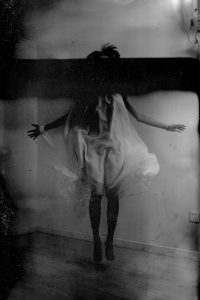 “Flyover” by Jen Julian
“Flyover” by Jen Julian
In “Flyover” we begin with the rupture: people have been falling from the sky. While the occupants of the town into which these people fall try to rationalise their appearance (the narrator’s mother “brings religion into it”), they are less concerned with the why and how of these events. Rather, they work to navigate the issue, which has become something they are used to. At the point of the story, the rupture is already beyond repair; all that the town’s occupants can do is deal with it, in ways that create ruptures of their own.
Exercise: write a story in which people from one world appear in another. On a separate piece of paper, write what exactly is causing this phenomenon. Find a way to articulate these reasons in your story without explicitly stating them.
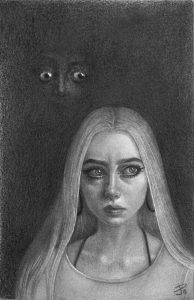 “Lucy Ignores Death” by L. Soviero
“Lucy Ignores Death” by L. Soviero
In “Lucy Ignores Death” story, the main character, Lucy, ignores the fact that she has died while swimming in the sea during a date with a boy. She just continues to live – she falls in love, marries, has children. Lucy’s death doesn’t even arise in her memory until she is an old woman, and even then it is a non-event: “she won’t even dwell on this realisation long because a drip in the faucet will distract her”. While the previous story surrounds a rupture, magical realism is used in this story to bypass it. Something terrible has happened, but life is allowed to go on despite it.
Exercise: write a story in which “life goes on” in the aftermath of a tragedy in a way that suspends belief.
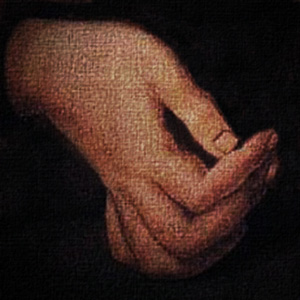 “Wei Ch’i” by Vanessa Gebbie
“Wei Ch’i” by Vanessa Gebbie
In “Wei Ch’i” the main character comes home to find his wife’s body all over the house, in pieces. Yet what has happened doesn’t appear initially as an act of violence: there is no blood, no randomness – the bits of his wife are arranged neatly, precisely, as clean and smooth as “waxwork”. At the end of the story we hear that previous to this event, the wife announced something to her husband that was world-shattering to him, revealing their relationship to be a lie. The reader is asked to draw their own conclusions as to what exactly has happened to the wife – has she left, leaving the husband with only memory? Has he come back to his wife, but finds himself unable to approach her anymore? What the reader is left with, however, is the knowledge that it is the wife’s face and heart that are not to be found, “now matter how close they might have been”.
Exercise: write a story in which a character is metaphysically wounded, and have them deal with that wound in a way that bends reality.
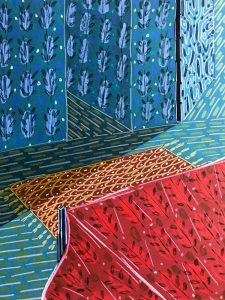 “After the Third Notice, the City Shuts Off Our Power” by Wynne Hungerford
“After the Third Notice, the City Shuts Off Our Power” by Wynne Hungerford
Here, the main crisis in the story is due to poverty – a state of perpetual suspension. “After the Third Notice, the City Shuts Off Our Power” is what it says on the tin: a family’s response to the coldness of their house after their power is shut off. There is no material solution that the childrens’ parents have to this problem — the blanket and the faint warmth of candlelight they do have to dispel the cold is not enough. In place of this material lack, their father responds with a solution that pushes our ideas of reality. The story speaks to what can be done when what physically can be done is not enough.
Exercise: write a story in which parents explain a trauma (historical, personal, or both) to their children, but use the language of magical realism to do so.
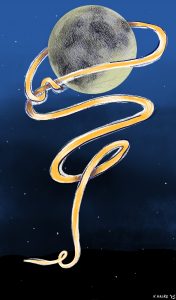 “The Moon is a Wasteland” by Daniel DiFranco
“The Moon is a Wasteland” by Daniel DiFranco
While most of our previous examples of the genre have been bleak, “The Moon is a Wasteland” is a more uplifting example of the genre (despite the title). In it, a young boy lassos down the moon and gives it to a girl he fancies. She rejects his gift, which causes him some grief, but his response is an unmooring that is regenerative instead of regressive: he lets ships out to sea, releases the stars back into the sky, and puts the moon back in its place. In his author interview, DiFranco states that he didn’t find a need to explain the “rules” of his setting: “Thomas wanted the moon? He got it. Simple.” A child’s imagination is a fertile place for magical realism, a space in which the inexplicable is allowed to mingle with the everyday, expressing the hybridity inherent in the genre.
Exercise: write a story in which children inhabit realms of their own. Maurice Sendak’s Where the Wild Things Are is, of course, a prime example of this type of story — it may be a children’s tale, but its wilderness can be a good place for adults to inhabit, even just for a while.
__________________________

Sharmini Aphrodite was born in Sabah. She was raised – and still lives – between the cities of Johor Bahru and Singapore. Her short fiction has appeared online and in print, and has been shortlisted for the Commonwealth Short Story Prize, Australian Book Review Jolley Short Story Prize, and the Singapore National Art Council’s Golden Point Awards. Her art writing can be found online.

 The core workshop of SmokeLong Fitness is all in writing, so you can take part from anywhere at anytime. We are excited about creating a supportive, consistent and structured environment for flash writers to work on their craft in a community. We are thrilled and proud to say that our workshop participants have won, placed, or been listed in every major flash competition. Community works.
The core workshop of SmokeLong Fitness is all in writing, so you can take part from anywhere at anytime. We are excited about creating a supportive, consistent and structured environment for flash writers to work on their craft in a community. We are thrilled and proud to say that our workshop participants have won, placed, or been listed in every major flash competition. Community works.